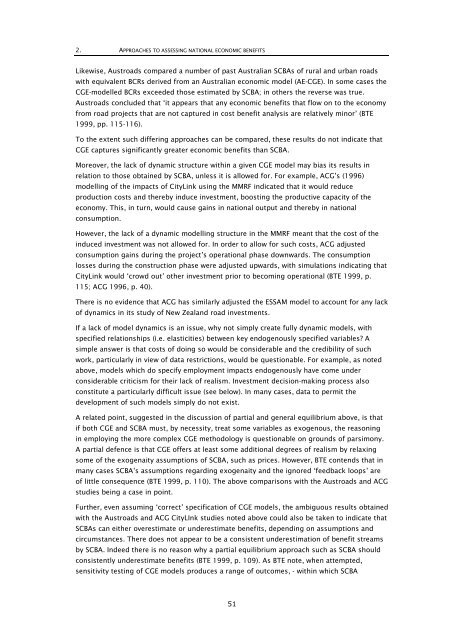Research 350 - NZ Transport Agency
Research 350 - NZ Transport Agency
Research 350 - NZ Transport Agency
You also want an ePaper? Increase the reach of your titles
YUMPU automatically turns print PDFs into web optimized ePapers that Google loves.
2. APPROACHES TO ASSESSING NATIONAL ECONOMIC BENEFITS<br />
Likewise, Austroads compared a number of past Australian SCBAs of rural and urban roads<br />
with equivalent BCRs derived from an Australian economic model (AE-CGE). In some cases the<br />
CGE-modelled BCRs exceeded those estimated by SCBA; in others the reverse was true.<br />
Austroads concluded that ‘it appears that any economic benefits that flow on to the economy<br />
from road projects that are not captured in cost benefit analysis are relatively minor’ (BTE<br />
1999, pp. 115-116).<br />
To the extent such differing approaches can be compared, these results do not indicate that<br />
CGE captures significantly greater economic benefits than SCBA.<br />
Moreover, the lack of dynamic structure within a given CGE model may bias its results in<br />
relation to those obtained by SCBA, unless it is allowed for. For example, ACG’s (1996)<br />
modelling of the impacts of CityLink using the MMRF indicated that it would reduce<br />
production costs and thereby induce investment, boosting the productive capacity of the<br />
economy. This, in turn, would cause gains in national output and thereby in national<br />
consumption.<br />
However, the lack of a dynamic modelling structure in the MMRF meant that the cost of the<br />
induced investment was not allowed for. In order to allow for such costs, ACG adjusted<br />
consumption gains during the project’s operational phase downwards. The consumption<br />
losses during the construction phase were adjusted upwards, with simulations indicating that<br />
CityLink would ‘crowd out’ other investment prior to becoming operational (BTE 1999, p.<br />
115; ACG 1996, p. 40).<br />
There is no evidence that ACG has similarly adjusted the ESSAM model to account for any lack<br />
of dynamics in its study of New Zealand road investments.<br />
If a lack of model dynamics is an issue, why not simply create fully dynamic models, with<br />
specified relationships (i.e. elasticities) between key endogenously specified variables? A<br />
simple answer is that costs of doing so would be considerable and the credibility of such<br />
work, particularly in view of data restrictions, would be questionable. For example, as noted<br />
above, models which do specify employment impacts endogenously have come under<br />
considerable criticism for their lack of realism. Investment decision-making process also<br />
constitute a particularly difficult issue (see below). In many cases, data to permit the<br />
development of such models simply do not exist.<br />
A related point, suggested in the discussion of partial and general equilibrium above, is that<br />
if both CGE and SCBA must, by necessity, treat some variables as exogenous, the reasoning<br />
in employing the more complex CGE methodology is questionable on grounds of parsimony.<br />
A partial defence is that CGE offers at least some additional degrees of realism by relaxing<br />
some of the exogenaity assumptions of SCBA, such as prices. However, BTE contends that in<br />
many cases SCBA’s assumptions regarding exogenaity and the ignored ‘feedback loops’ are<br />
of little consequence (BTE 1999, p. 110). The above comparisons with the Austroads and ACG<br />
studies being a case in point.<br />
Further, even assuming ‘correct’ specification of CGE models, the ambiguous results obtained<br />
with the Austroads and ACG CityLInk studies noted above could also be taken to indicate that<br />
SCBAs can either overestimate or underestimate benefits, depending on assumptions and<br />
circumstances. There does not appear to be a consistent underestimation of benefit streams<br />
by SCBA. Indeed there is no reason why a partial equilibrium approach such as SCBA should<br />
consistently underestimate benefits (BTE 1999, p. 109). As BTE note, when attempted,<br />
sensitivity testing of CGE models produces a range of outcomes, - within which SCBA<br />
51
















